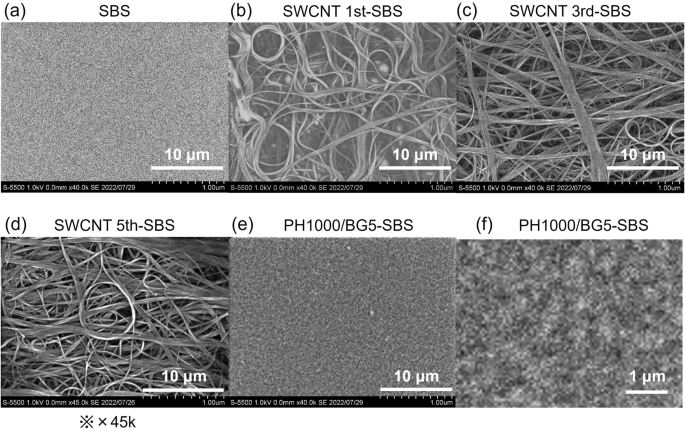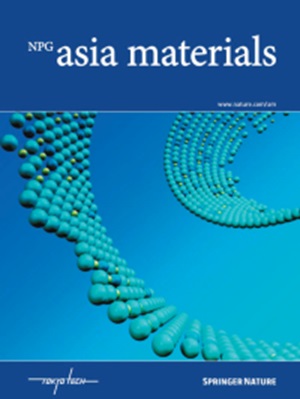由组装在弹性薄膜上的单壁碳纳米管网络组成的具有高水蒸气渗透性和可拉伸特性的超薄皮肤适形电极
IF 8.3
2区 材料科学
Q1 MATERIALS SCIENCE, MULTIDISCIPLINARY
引用次数: 0
摘要
在此,我们报告了具有拉伸性和水蒸气渗透性的导电超薄薄膜(纳米片),可用于皮肤适形生物电极。这种薄膜是通过将单壁碳纳米管(SWCNT)和聚(苯乙烯-丁二烯-苯乙烯)纳米片(即 SWCNT-SBS 纳米片)的导电纤维网络结合在一起制成的。随着 SWCNT 涂层数量的增加,SWCNT 束的厚度和密度也随之增加。涂覆了三层 SWCNT 的 SBS 纳米片(即 SWCNT 3rd-SBS 纳米片)与涂覆了含有 5 wt.% 丁二醇的掺杂聚(4-苯乙烯磺酸)的聚(3,4-亚乙二氧基噻吩)(PEDOT:PSS)的 SBS 纳米片(即 PEDOT:PSS/BG5-SBS 纳米片)具有相当的薄层电阻。此外,与 PEDOT:PSS/BG5-SBS 纳米片相比,SWCNT 3rd-SBS 纳米片的弹性模量显著降低,断裂伸长率显著增加。此外,计算得出的 210 纳米厚 SBS 纳米片的水蒸气透过率(268172 g m-2 (2 h)-1)高于滤纸(6345 g m-2 (2 h)-1)。附着在模型皮肤上的 SWCNT 第 3 代-SBS 纳米片对不同 pH 值下的弯曲和人工汗液表现出很高的耐受性(即电阻变化~1.1 倍)。最后,将 SWCNT 3rd-SBS 纳米片用于检测受试者前臂的表面肌电图。这种纳米片显示出与 PEDOT:PSS/BG5-SBS 纳米片相似的信噪比。本文章由计算机程序翻译,如有差异,请以英文原文为准。


Ultrathin skin-conformable electrodes with high water vapor permeability and stretchability characteristics composed of single-walled carbon nanotube networks assembled on elastomeric films
Herein, we report on conductive ultrathin films (nanosheets) with the characteristics of stretchability and water vapor permeability for skin-conformable bioelectrodes. The films are fabricated by combining conductive fibrous networks of single-wall carbon nanotubes (SWCNTs) and poly(styrene-b-butadiene-b-styrene) (SBS) nanosheets (i.e., SWCNT-SBS nanosheets). An increase in the number of SWCNT coatings increases both the thicknesses and densities of the SWCNT bundles. The SBS nanosheets coated with three layers of SWCNTs (i.e., SWCNT 3rd-SBS nanosheets) show comparable sheet resistance to the SBS nanosheets coated with poly(3,4-ethylenedioxithiophene) doped with poly(4-styrenesulfonate acid) (PEDOT:PSS) containing 5 wt.% butylene glycol (i.e., PEDOT:PSS/BG5-SBS nanosheets). In addition, the SWCNT 3rd-SBS nanosheets exhibit significantly reduced elastic moduli and increased elongations at break compared to the PEDOT:PSS/BG5-SBS nanosheets. Furthermore, the calculated water vapor transmission ratio of the 210-nm-thick SBS nanosheets (268,172 g m−2 (2 h)−1) is greater than that of the filter paper (6345 g m−2 (2 h)−1). The SWCNT 3rd-SBS nanosheets attached to model skin show high tolerances to bending and artificial sweat at different pH values (i.e., the electrical resistance changes ~1.1 times). Finally, the SWCNT 3rd-SBS nanosheet is applied to detect the surface electromyogram from the forearm of a subject. This nanosheet displays a signal-to-noise ratio similar to that of the PEDOT:PSS/BG5-SBS nanosheet. We report on conductive ultrathin films (referred to as “nanosheets”) with stretchability and water vapor permeability for skin-conformable bioelectrodes. By combining conductive fibrous networks of single-wall carbon nanotubes and poly(styrene-b-butadiene-b-styrene) continuous nanosheets (i.e., SWCNT-SBS nanosheets), the conductive nanosheet shows a high tolerance to bending on a model skin sheet and a high permeability to humidity. Finally, we demonstrate that the conductive nanosheet can detect the surface electromyogram signals from a subject’s forearm.
求助全文
通过发布文献求助,成功后即可免费获取论文全文。
去求助
来源期刊

Npg Asia Materials
MATERIALS SCIENCE, MULTIDISCIPLINARY-
CiteScore
15.40
自引率
1.00%
发文量
87
审稿时长
2 months
期刊介绍:
NPG Asia Materials is an open access, international journal that publishes peer-reviewed review and primary research articles in the field of materials sciences. The journal has a global outlook and reach, with a base in the Asia-Pacific region to reflect the significant and growing output of materials research from this area. The target audience for NPG Asia Materials is scientists and researchers involved in materials research, covering a wide range of disciplines including physical and chemical sciences, biotechnology, and nanotechnology. The journal particularly welcomes high-quality articles from rapidly advancing areas that bridge the gap between materials science and engineering, as well as the classical disciplines of physics, chemistry, and biology. NPG Asia Materials is abstracted/indexed in Journal Citation Reports/Science Edition Web of Knowledge, Google Scholar, Chemical Abstract Services, Scopus, Ulrichsweb (ProQuest), and Scirus.
 求助内容:
求助内容: 应助结果提醒方式:
应助结果提醒方式:


